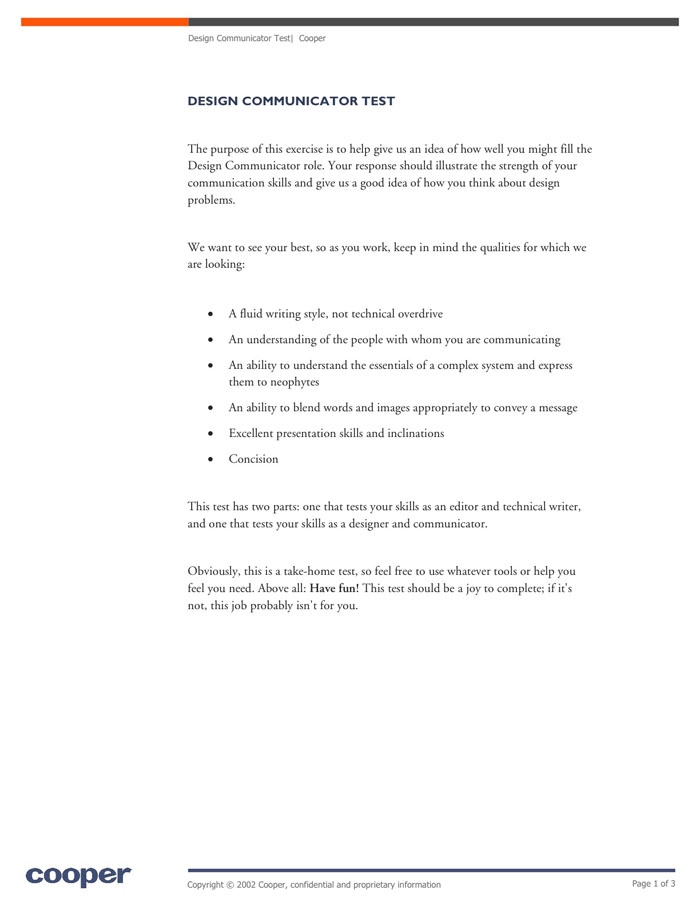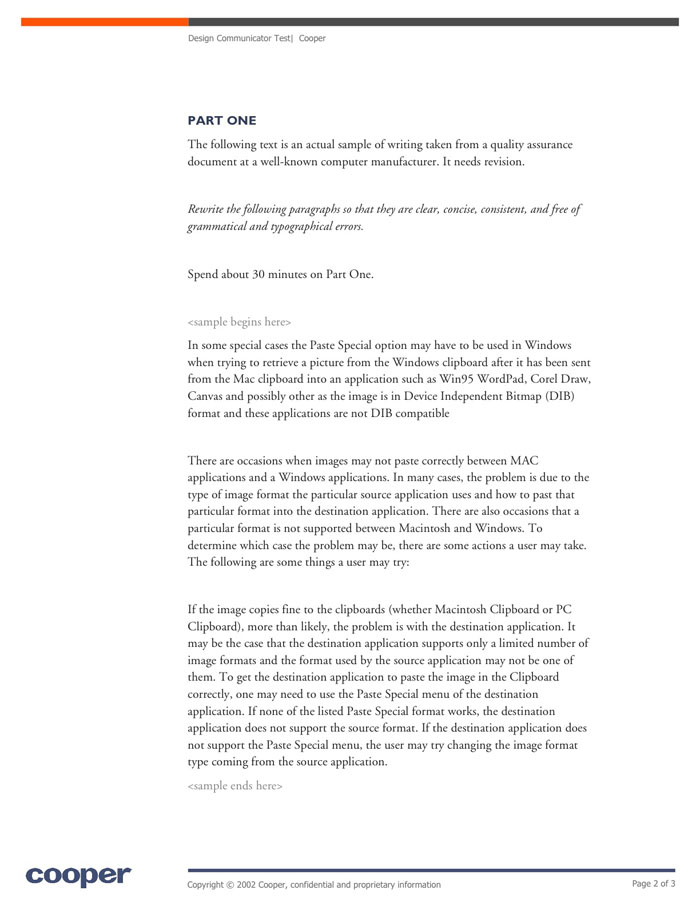Cooper’s Design Communicator Test and my response


PART ONE (my response)
You may run into trouble when trying to copy and paste images from Mac applications to Windows applications or from Windows applications to Mac applications. In many cases, the trouble arises because the format of the image (.jpg, .tff, .bmp, etc.) is supported by the source application (where you’re copying the image from) but it is not supported by the destination application (where you’re trying to paste the image).
To solve this problem, try copying your image and then using the ‘Paste Special...’ command instead of the ‘Paste’ command. The ‘Paste’ command automatically chooses the image’s format for you, but the ‘Paste Special...’ command lets you choose the format of the image. Try pasting the image using different formats. Hopefully, you will find one that works, but it may be that none of them will. (The ‘Copy’, ‘Paste’, and ‘Paste Special...’ commands are usually found on the dropdown menu under the ‘Edit’ tab on your menu bar.)
If your destination application does not have a ‘Paste Special...’ command, then you can try changing the format of the image in the source application, by using the ‘Save As...’ command, and then using the ‘Copy’ command (in the source application) and the ‘Paste’ command (in the destination application).
Again, this problem is not always fixable. Sometimes there is no image format that is supported by both the source application and the destination application. In such cases, copying and pasting an image from one application to the other will be impossible.
Note:
I made some assumptions here that might be incorrect. If this were a real assignment for me, I would have to confirm that (1) when a format is not supported between the Mac and Windows operating systems, there is nothing one can do to fix the problem, and (2) sometimes it is impossible to copy and paste an image from one application to another because there is no image format that both applications support. The feeling I got from reading the sample passage was that both (1) and (2) are true, and so I rewrote the passage as if they were, but the words in the sample passage leave room for the possibility that (1) and/or (2) are false.

PART TWO (my response)
To convey how direct-dial touch-tone telephones work to an ordinary person of 1850, whom I’ll call ‘Tom Smith’, I would use a model. I would build a model network of four telephones (three residential and one for the operator) and place them inside three miniature houses and one miniature office building all with removable roofs so that the telephone inside of each house could be accessed. Each telephone would be labeled with its telephone number and the name of the owner.
The four phones would be labeled as follows:
(House 1)
Tom Smith
555-1234
(House 2)
John Doe
555-4512
(House 3)
Jane Doe
555-9623
(Office)
Operator
0
I would have three colleagues play the roles of John Doe, Jane Doe, and the operator. I would show Tom Smith how to use the keypad on his phone to dial the phone number of John Doe. John Doe’s phone would ring and John Doe would answer it. After they hang up, I would have Tom Smith dial Jane Doe’s phone number. Jane Doe’s phone would ring and she would answer it. After they hang up, I would ask John Doe to call Jane Doe by going through the operator. Once Tom Smith saw how that worked, I would have him try it for himself; I would ask Tom Smith to call John Doe by going through the operator. I would tell Tom Smith to dial ‘0’ and say, “John Doe, please,” when the operator answered his call. To show that telephone conversations can take place over long distances, I would have my colleagues extend their phone lines and walk far away (out of earshot) with their miniature houses and then have one of them place a call to Tom Smith.